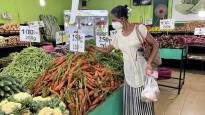The misery that has lasted for almost a year in the island nation south of India is not abating. Sri Lanka cannot afford to pay off its debt to foreign countries. That is why Sri Lankans cannot afford to eat now.
Sri Lanka will have to tighten the belts of its citizens even more to get out of its debts. In February, it raised the price of electricity again, this time by a whopping 66 percent.
– We know that this is hard for the people, especially the poor, but we have no other option but to price electricity according to costs, said the Minister of Energy Kanchana Wijesekera to journalists in Colombo.
Today, Friday, the country’s central bank announced a significant increase in interest rates.
The reason is the conditions of the International Monetary Fund (IMF), by following which Sri Lanka can get a loan of 2.7 billion euros. Sri Lanka needs to reduce public debt and raise taxes. The creditor countries, on the other hand, have to soften the terms of the loan.
The country of 22 million people is in the worst debt crisis since it gained independence from Britain in 1948.
The people cannot afford belt-tightening
However, many Sri Lankans have not been able to afford to eat enough. Now half of the families have had to Research by the Save the Children organization (you will switch to another service) along to haggle over the children’s food.
The shortage has continued for almost a year. In April last year, people took to the streets when the price of food rose and the country ran out of fuel. Power cuts were commonplace.
Inflation in Sri Lanka is still running at 54 percent. The tax rate has risen to 36.
Sri Lanka owes the world more than 40 billion euros. The largest creditor country is China, which has given a loan of over 7 billion euros. However, private international banks and financiers are even bigger creditors.
Too much debt has been taken on from abroad
Economist Lalithasiri Gunaruwan from the University of Colombo accuses Sri Lanka of recklessly drifting into the crisis. He says that the crisis has been brewing for decades. The country has been living in debt since the 1970s without worrying about the debt burden.
– Every year Sri Lanka’s imports exceeded exports. Our export earnings were not enough to pay for imports in foreign currency. We lived beyond our means, Gunaruwan explains.
The world economic crisis exacerbated by the war in Ukraine raised prices and collapsed the debt-burdened economy.
According to Gunaruwan, it was import liberalization and inequality that initially led to indebtedness. The country’s economy was opened in 1977.
– The country’s economy was opened blindly. We no longer invested in locally made products, he says.
The world-famous tea production, tourism and clothing manufacturing were not enough to bring in enough income to pay the debts.
Sri Lanka also took care of the poor with various subsidies. According to the economist, the poor condition of the economy therefore remained hidden from the public for such a long time.
– We lived beyond our means, but the people didn’t feel it until the symptoms started in 2021. But the cancer grew. The debt and budget deficit only increased. There was still enough fuel until suddenly the endurance ran out, Gunaruwan says.
China’s role is significant
China has been accused of driving Sri Lanka into a debt crisis. It is the largest creditor country.
Hambantota port has been built with Chinese money, among other things. It was given to China for 99 years when Sri Lanka could not afford to repay its debt.
Gunaruwan still denies that China is to blame for the debt trap. He blames Sri Lanka’s past administrations for paying off the debt with new debt and eventually selling off the nation’s assets.
– If we had used the money we got from Hambantota to pay the debt to China, that would have been good. But the debt was not paid. Instead, we continue to pay for imports and the people just consume, he criticizes.
Economist says all lenders act like China. Too often, the condition of the loan is that the services for construction projects must be purchased from the companies providing the loan, even if the country could do the same more cheaply.
Gunaruwan reminds that the interest rates on loans taken from private financial institutions are even higher than creditor countries’ loan terms, short-term loans.
Prices will rise, people will soon be on the street again
Last year, the president Gotabaya Rajapaksa resigned when the people protested violently due to the economic crisis. The new president Ranil Wickremesinghe promised to get Sri Lanka back on its feet, but problems persist.
According to Gunaruwan, belt-tightening is the only way to improve Sri Lanka’s economy. He reminds that even the IMF aid package must be paid back.
– If we don’t take on debt, we will have to regulate consumption. Now the government is regulating fuel and has stopped importing 300 products. This is how it should be done, he says.
Gunaruwan warns that indebtedness endangers the country’s financial independence and sovereignty when creditors gain too much power over the country’s economy. He fears that Sri Lanka will end up selling off more state assets like the Hambantota port.
– Our poor people own these country’s resources. The government has no right to sell them off. Future generations will lose their ownership of the country’s capital. It’s criminal, he snorts.
Sri Lanka still has a painful long belt-tightening ahead of it. Prices are still rising and people are threatening to take to the streets.
More on the topic on TV news at 8:30 p.m.
